





Survey of Historic Sites and Buildings
 |
BEECHER'S ISLAND BATTLEFIELD Colorado |
 |
| ||
In an indecisive but bitterly fought battle at this site, a force of about 50 frontiersmen under Maj. George A. Forsyth engaged more than 1,000 Sioux and Cheyennes, led by Roman Nose, Pawnee Killer, and other chiefs. Pursued all the way from Fort Wallace, Kans., on September 16, 1868, the Indians turned on the troops, who entrenched themselves on a small sandy island in the Arikaree River. During the 9-day siege and the repeated Indian charges that followed, volunteers worked their way through enemy lines to obtain reinforcements from Fort Wallace, 125 miles away, who drove off the Indians. Casualties were heavy on both sides. Half the soldiers were wounded, Forsyth four times. The dead included Roman Nose and Lt. Frederick W. Beecher, after whom the island came to be named. Immediately after this battle, Maj. Gen. Philip H. Sheridan began his 1868-69 winter campaign.
The island has long since disappeared because of shifting river channels, but a large monument near the post office at the town of Beecher Island commemorates the battle.
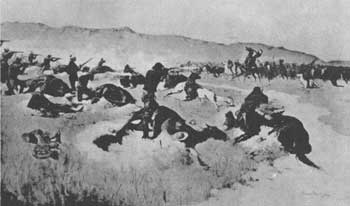 |
| Frederic Remington's version of the Battle of Beecher's Island. (Jeff C. Dykes) |
 |
BENT'S NEW FORT Colorado |
 |
| ||
William Bent abandoned Bent's Old Fort in 1849 and moved 38 miles down the Arkansas River to the Big Timbers locality, a favorite Cheyenne and Arapaho campground. There he erected a temporary log stockade on the north bank of the river and resumed trading. In 1852-53 he replaced the stockade with a permanent stone structure that came to be known as Bent's New Fort. Resembling Bent's Old Fort, but smaller, it consisted of 12 rooms surrounding a central courtyard. It had parapets but no bastions, and cannon were placed on the corners of the roof. The walls were 16 feet high. The fort was never a success, for by the time of its founding the Indian trade was rapidly decreasing. Emigrants, gold seekers, and increased freight traffic had made the Arkansas River a main-traveled highway. They felled the cottonwoods at Big Timbers and frightened away the game.
In 1860 troops began construction of Fort Wise (Fort Lyon No. 1) a mile southwest of Bent's post. Bent leased it to the Army and moved upriver to the mouth of the Purgatoire River, where he built a wooden stockade and lived until his death in 1869. The Army, which used Bent's New Fort as a commissary warehouse, erected extensive earthworks around it and diamond-shaped gun emplacements at the corners. In 1867 soldiers built Fort Lyon No. 2 near present Las Animas, Colo., and abandoned Fort Lyon No. 1 and Bent's New Fort.
The buildings of Bent's New Fort disintegrated many years ago, but their outlines are visible. Earthwork remains are substantial. A marker indicates the site, in private ownership.
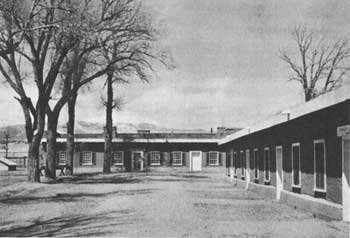 |
| Restored barracks at Fort Garland State Historical Monument. (photo by Robert M. Utley, National Park Service) |
 |
FORT GARLAND Colorado |
 |
| ||
In southern Colorado near La Veta Pass and an Indian trail running between the Rio Grande and the Arkansas River Valley, this fort (1858-83) replaced Fort Massachusetts, 6 miles to the north. The new post protected settlers in the San Luis Valley and warded off Ute and Apache attacks on the roads running south to Taos. During the Civil War, the fort was an assembly point for Colorado Volunteers; and the garrison participated in the Battle of Glorieta Pass, N. Mex. (1862), which turned back the Confederate invasion from Texas. In 1866-67 Col. "Kit" Carson was the commander. In the former year, accompanied by Lt. Gen. William T. Sherman, he held a council with the Ute chief Ouray. This, along with concessions that Carson gained for the tribe in an 1868 treaty, was instrumental in keeping it peaceful, even during the Ute uprising of 1879 in western Colorado. Nonetheless, at that time reinforcements arrived at Fort Garland, and 2 years later troops removed the local Utes to Utah.
Today a State historical monument, Fort Garland features seven restored buildings: five officers' quarters, the cavalry barracks, and the infantry barracks. Of adobe construction, they have flat, earth-covered roofs and viga ceilings. A large museum is divided among the buildings. An eighth structure, the sutler's store, not owned by the State, is a private residence.
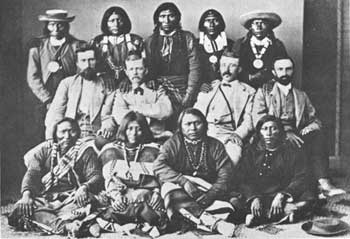 |
| Southern Ute chiefs and Government officials in Washington, D.C., about 1874. Chief Ouray is second from right, front row. (Colorado Historical Society) |
 |
FORT LYON NO. 1 (Fort Wise) Colorado |
 |
| ||
Established by Colorado Volunteers in 1860 on the north bank of the Arkansas River a mile upstream from Bent's New Fort, Fort Lyon No. 1 was known as Fort Wise until 1862. Two years after its founding the garrison marched into New Mexico and helped defeat a Confederate force from Texas in the Battle of Glorieta Pass. During the rest of the Civil War the post was the principal guardian of the Mountain Branch of the Santa Fe Trail. Cooperating with detachments from Fort Larned, Kans., and Fort Union, N. Mex., its troops escorted traffic along the upper reaches of the Arkansas to Raton Pass.
The fort was also involved with the uprising of Southern Cheyennes and Arapahos in Colorado that reached a climax in 1864. Three years before, a few chiefs, pacified by Col. Edwin V. Sumner's 1857 campaign, had concluded the Treaty of Fort Wise. Guaranteeing peace along the Santa Fe Trail and in the region, they relinquished all the territory assigned to their tribes by the Fort Laramie Treaty (1851) and promised to settle on a reservation in the area of the upper Arkansas. But most of the other chiefs, refusing to be bound by the treaty, kept on hunting buffalo between the Platte and the Arkansas. Miners and settlers continued to flow into Colorado, whose Regular garrisons were serving in the Civil War. In the spring of 1864 the predictable collision occurred. Throughout the summer, warriors raided roads and settlements and practically halted traffic on the Santa Fe Trail. Coloradans obtained their revenge at Sand Creek, only 40 miles down the Arkansas from Fort Lyon No. 1, where a group of peaceful Indians who thought they were under the post's protection were slaughtered. Infuriated, the Plains Indians launched a full-scale war.
During the summer of 1867, because of floods, unhealthful conditions, and the decreasing supply of timber, the Army relocated the fort 20 miles upstream and redesignated it as Fort Lyon No. 2. For a time, however, a Kansas City-Santa Fe line used the dirt-roofed stone buildings at the first Fort Lyon as a stage station.
All that remains at the site, in private ownership but indicated by a stone marker, are traces of the building outlines.
 |
FORT LYON NO. 2 Colorado |
 |
| ||
The successor of Fort Lyon No. 1, this fort (1867-89) was also located on the Arkansas River, on a bluff about 2 miles below the mouth of the Purgatoire. By the time of its activation the need for protection of the Mountain Branch of the Santa Fe Trail had lessened, the Confederate threatened, and the focus in the Indian campaigns shifted to Kansas and Indian Territory. Troops from the fort, however, did play a small part in General Sheridan's 1868-69 campaign. One of the three participating columns, led by Maj. Eugene A. Carr, moved southeastward in brutal weather, founded a supply base on the North Canadian River some 100 miles west of Camp Supply, Okla., reached the Canadian River, and turned back without ever having seen any Indians.
The Navy utilized the fort in the 1906-22 period, and since 1934 it has been a Veterans' Administration hospital. Various adobe and stone structures, some remodeled and used by the Veterans' Administration but all in good condition, date from the 1860's. Among them are the commissary building, several officers quarters, storehouses, and the commanding officer's residence. The building where "Kit" Carson died has been altered and now serves as a chapel.
 |
FORT SEDGWICK AND JULESBURG Colorado |
 |
| ||
Early in 1865 this fort (1864-71) and town on the south bank of the South Platte felt the wrath generated among the southern Plains Indians by the Sand Creek Massacre (November 1864). The fort had been founded during the Indian uprisings in Colorado that peaked in the summer of 1864 and was responsible for protecting settlers, emigrants, and the overland route to Denver. The town of Julesburg, just to the east, was a stage and freight station. On January 7, 1865, a thousand Cheyennes, Arapahos, and Sioux attacked the weakly garrisoned post, but failed to take it and sacked the town. A few weeks later, on February 18, they again pillaged the town, this time burning it to the ground. Thereafter the focus of hostilities shifted north of the Platte. No attempt was made to rebuild Julesburg, and it subsequently occupied three different sites nearby, including that of the present town.
The privately owned sites of the adobe fort and the first Julesburg are located in plowed fields. No remains of either are extant. A stone monument marks the original Julesburg site. The modern town contains the Julesburg Historical Museum, operated by the Fort Sedgwick Historical Society. It interprets the history of the fort and the towns.
 |
MEEKER (NATHAN C.) HOME Colorado |
 |
| ||
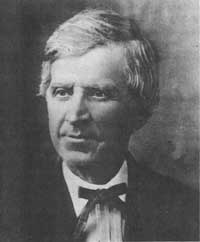 |
| Nathan C. Meeker, idealistic Indian agent, killed in 1879 by his rebellious Ute charges. (photo by W. G. Chamberlain, Denver Public Library, Western Collection) |
This was the residence of Nathan C. Meeker, idealistic founder of the city of Greeley, who later died a martyr's death as an Indian agent. Born in 1817 in Euclid, Ohio, he early became a wanderer around the East. Changing vocations often, he worked as a journalist, author, social reformer, teacher, and businessman. In 1865 he joined Horace Greeley's New York Tribune, eventually becoming its agricultural editor. Like Greeley, Meeker had a deep interest in the West, expressed in his book Life in the West (1866). While on a newspaper trip to the Rocky Mountain region in 1869, he evolved a plan to organize an agricultural colony there. On his return to the East later that year, supported by Greeley, he launched his Union Colony of Colorado and recruited 200 colonists.
The next year Meeker set out to found Greeley, an experimental cooperative community, in northeastern Colorado. After several false starts, it succeeded. Despite his wanderlust, Meeker stayed there for 8 years. To repay debts he had incurred and to confirm his belief that agriculture could bring self-sufficiency and prosperity to the Indians, as well as a better adjustment to the ways of the whites, at the age of 60 he enthusiastically obtained a position as Indian agent at the White River Agency, Colo. But the next year his Ute charges murdered him, and his family returned to their home in Greeley.
The two-story home, completed in the year 1871 and a city-operated museum since 1929, is still essentially in its original condition, except for the addition of a kitchen. In 1959 extensive restoration took place. At that time the house was equipped with furnishings, some of them dating to the 1870's and belonging to the Meeker family.
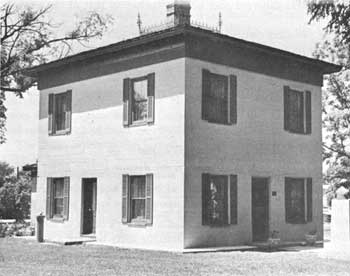 |
| Nathan C. Meeker Home. (Greeley Municipal Museums Department) |
 |
MEEKER MASSACRE SITE Colorado |
 |
| ||
The Ute uprising of 1879 began at this site, the location of the White River Agency and the scene of the Meeker Massacre. With the possible exception of the Ghost Dance outbreak of the Sioux in 1890, the massacre was probably the most violent expression of Indian resentment toward the reservation system. The agency had been founded in 1873 for several bands of Utes, who had agreed in a treaty that year to settle on a reservation. Five years later Nathan C. Meeker, founder of the city of Greeley, assumed the duties of Indian agent. Resisting his undiplomatic and stubborn efforts to make them farm, raise stock, discontinue their pony racing and hunting forays, and send their children to school, as well as resenting settler encroachment on their reservation and Indian Bureau mismanagement, the nomadic Utes revolted. Assaulted by a subchief during a petty quarrel, Meeker called for troops. On September 29, 1879, before they arrived, the Indians attacked the agency, burned the buildings, and killed Meeker and nine of his employees. Meeker's wife, daughter, and another girl were held as captives for 23 days. After the massacre, relief columns from Forts Fred Steele and D. A. Russell, Wyo., defeated the Utes in the Battle of Milk Creek, Colo., and ended the uprising.
The site, indicated by a wooden marker on the south side of the highway, is in a privately owned meadow on the north side of the White River. A few traces of building foundations reveal the location of the Indian agency. A monument indicates the spot where Meeker died.
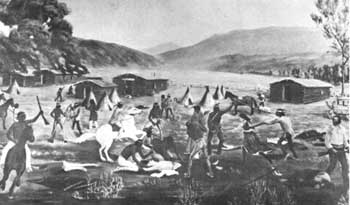 |
| The Meeker Massacre, rendered by an unknown artist. (Colorado Historical Society) |
 |
MILK CREEK BATTLEFIELD Colorado |
 |
| ||
Following the Meeker Massacre, the Utes ambushed a column of 150 troops under Maj. Thomas T. Thornburgh at this site on the northern edge of the White River Reservation, approximately 18 miles from the Indian agency. The soldiers had marched south from Fort Fred Steele, Wyo., in answer to Meeker's plea for help. Forming a wagon corral and sending out a messenger with a call for aid, they held out from September 29 until October 5, 1879. During that time, 35 black cavalrymen, based at Fort Lewis, Colo., broke through the Indian line to reinforce their comrades-in-arms. A relief expedition of 350 men led by Col. Wesley Merritt from Fort D. A. Russell, Wyo., finally lifted the siege and rounded up the hostiles. Army casualties were 13 dead, including Major Thornburgh, and 43 wounded. The Government imprisoned several of the Ute leaders, and placed the tribe on a new reservation, in Utah.
The battlefield, situated in a brush-lined canyon, appears today much as it did in 1879. A monument bears the names of the dead soldiers.
 |
SUMMIT SPRINGS BATTLEFIELD Colorado |
 |
| ||
The Battle of Summit Springs represented the culmination of General Sheridan's 1868-69 campaign. Maj. Eugene A. Carr, commanding five companies of the 5th Cavalry from Fort McPherson, Nebr., and 150 Pawnee scouts under Maj. Frank North and Capt. Luther North, guided by "Buffalo Bill" Cody, were pursuing Chief Tall Bull and his Cheyenne "Dog Soldiers," who had been plundering settlements in Kansas and eastern Colorado. On July 11, 1869, the troops surprised the Cheyennes at Summit Springs, killed 50 of them, including Tall Bull, and captured 117. Only one cavalryman was wounded.
The battlefield, privately owned pastureland, is indicated by a stone marker near the springs from which the battle took its name.
 |
 |
http://www.cr.nps.gov/history/online_books/soldier-brave/sitec3.htm
Last Updated: 19-Aug-2005